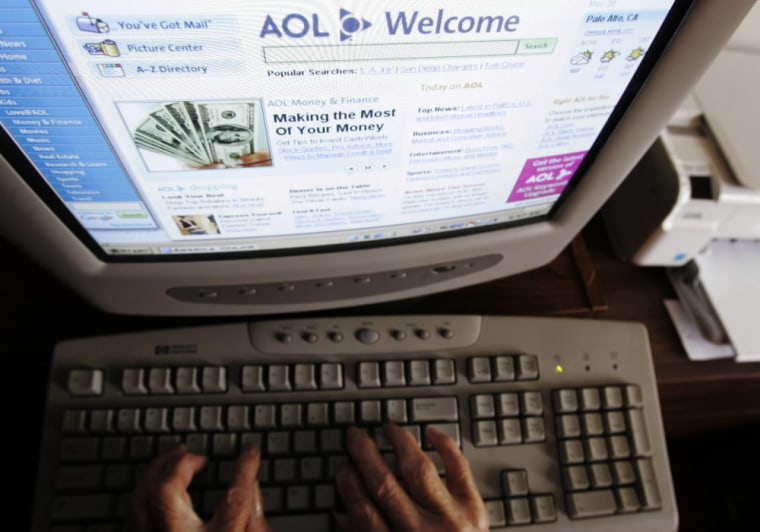When AOL flashed $147 billion in stock puffed up by the dot-com boom, Time Warner, one of the world's biggest media companies, fell into its arms in 2001. They swooned over their combination of Internet access and traditional media.
But before long, reality intruded. People were saying the marriage wouldn't last. Finally, after years of denial, Time Warner filed for the corporate world's version of a divorce Thursday. It said it will spin out AOL as a separate company and get on with its life as a movie, TV and publishing conglomerate.
Now AOL will try to bounce back even as its once-ubiquitous dial-up Internet access business fades away and its online advertising business struggles to pick up the slack.
The fix-it challenge falls to former Google Inc. advertising executive Tim Armstrong, 38, who was hired as AOL CEO in March to try to restore the luster to a brand once known as America Online.
Time Warner owns 95 percent of AOL and will buy out Google's 5 percent stake during the third quarter for an undisclosed amount. From there, AOL and its 7,000 employees will be spun off into a separate publicly traded company around the end of the year.
"For AOL, becoming a standalone company will give it more focus and strategic flexibility," Time Warner's chief executive, Jeff Bewkes, said at Time Warner's annual shareholder meeting Thursday in New York.
Meanwhile, Time Warner will focus on movies, cable TV networks such as HBO and CNN, and publishing magazines such as Time, People and Sports Illustrated.
AOL once defined the Web for millions of people. But much of its original revenue came from providing dial-up access, a business that peaked for AOL in 2002 at 26.7 million subscribers, back when the company stuffed free trial CDs in magazines and mailboxes. The march of broadband ate away at the business, and AOL had just 6.3 million dial-up subscribers at the end of the last quarter.
The decline undercut the premise that the content created by Time Warner's media empire would become even more valuable as AOL plumbed it to expand its Internet audience.
Even after AOL broadened its reach by giving away content and running free, ad-supported sites, that didn't create many new opportunities for Time Warner. Bewkes acknowledged last month that AOL helped promote material such as Warner Bros. movies or TNT television shows, but didn't bring in new revenue for the content. That function can be served just as well by Web portals the company doesn't own, like Yahoo or MSN.
It's no wonder that AOL Time Warner quickly disintegrated into one of the worst corporate combinations in history. In 2002 and 2003, Time Warner absorbed nearly $100 billion in charges to account for the rapidly diminishing value of the combined company. Time Warner even dropped AOL from its corporate name. Today, the combined value of AOL, Time Warner and Time Warner's recently spun off cable business totals around $40 billion.
At AOL in particular, the falloff has been stark. When Google agreed to pay $1 billion for its 5 percent stake in late 2005, the investment pegged AOL's market value at $20 billion. This past January, Google estimated its investment had plunged by more than 70 percent, leaving AOL with a market value of about $5.5 billion.
Today AOL gives away most of its services, like e-mail, to drive traffic to its ad-supported Web sites. But after a few strong quarters, ad growth slowed and then began declining. AOL also has Platform-A, a business that places ads on sites all over the Web, not just ones run by AOL. Yet that reach hasn't mattered enough: Both Yahoo Inc. and Google mine bigger profits from their ad businesses.
Although AOL's operations make money, its operating profit of $150 million in the first quarter marked a 47 percent drop from the same period in 2008.
Meanwhile, AOL's Web sites, which include celebrity gossip site TMZ and tech blog Engadget, averaged 106 million unique U.S. visitors each month during the first quarter, according to comScore Media Metrix — a drop from 110 million visitors in the first three months of 2008. The top three Web companies all posted gains in traffic in that same period: Google, Yahoo and Microsoft Corp.
Time Warner shares rose 55 cents, or 2.4 percent, to close at $23.55 on Thursday.
Frederick Moran, an analyst at The Benchmark Co., said investors and Time Warner shareholders will be pleased by the spinoff news because AOL has acted "almost like an anchor" on Time Warner's stock over the last few years.
Time Warner also recently spun out Time Warner Cable, which provides cable TV and broadband Internet access. Since then, Time Warner Cable's stock has risen 26 percent — but Time Warner shares have been essentially flat.
Ted Leonsis, an executive who retired from AOL in late 2006, said the decision to spin off AOL emphasizes a shift from seeking size and scale — two attributes that were in vogue 10 years ago — to a focus on being nimble and innovative.
"I'm thrilled for the employees and I don't see any other plan, so while it's a great decision it was an inevitable decision," he said.
Former Time Warner CEO Gerald Levin, who was instrumental in AOL's takeover, recently declined to comment about the looming breakup. Levin now works as director of a rehabilitation center in Southern California.
AOL co-founder Steve Case, the other main architect of the 2001 deal and the founder and CEO of investment company Revolution LLC, wrote Thursday on the short-messaging site Twitter that he is glad to see AOL set loose. He said it "has been a long, tortuous journey" and now is "time to open a new chapter."
